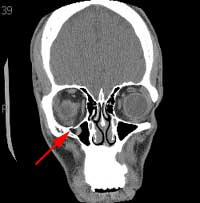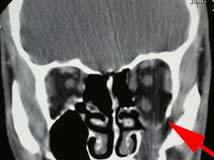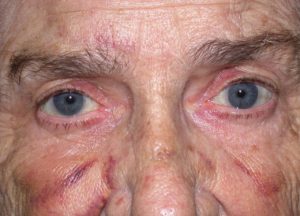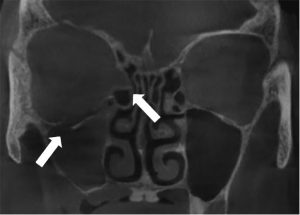
Orbit (Eye Socket) Fractures
The orbit or eye socket consists of four walls of bone which surround and protect the eye. Trauma to the eye area from things such as car accidents or a punch to the eye can result in fractures of these bones. At times, the muscles and/or the tissues of the eyeball can become entrapped within the bone fracture, restricting the ability to move the eye. Since the involved eye does not move with the normal eye, the person will see separate images with each eye and experience “double vision.” In these cases, surgery may be required to release entrapped eyeball tissue from the bone fractures.
This man was struck in the right eye with a fist. He has symptoms of double vision whenever he looks up. As seen in the photograph on the right, the right eye does not elevate properly.

Computed tomogram (“CAT scan”) demonstrating a fracture of the bone beneath the right eye with eye muscle tissue entrapped within the fracture (arrow).
Same patient after surgical repair of the fracture. Both eyes move together and he no longer has double vision.
This man injured his left orbit. His left eye is depressed downward and sunken inward.

Computed tomogram (“CAT scan”) demonstrating a large fracture beneath the bone of the left eye (arrow).
Same patient before and shortly after repair of the left orbital floor fracture. Note that the left eye has returned to its normal position.
Not all orbital fractures require surgery.


An elderly woman fell and fractured her right orbital floor and medial orbital wall (arrows). She has no double vision and the eye is in a normal position. Therefore, surgery is not necessary, and the fractures will not cause any problems in the future.
All photos are of patients seen and treated by Ronald E. Warwar, M.D.






